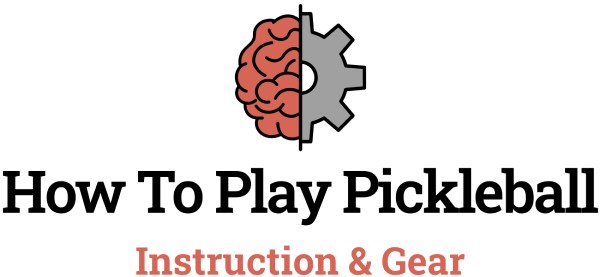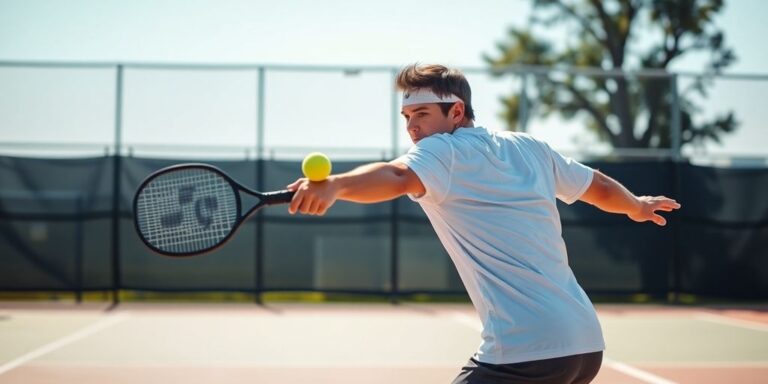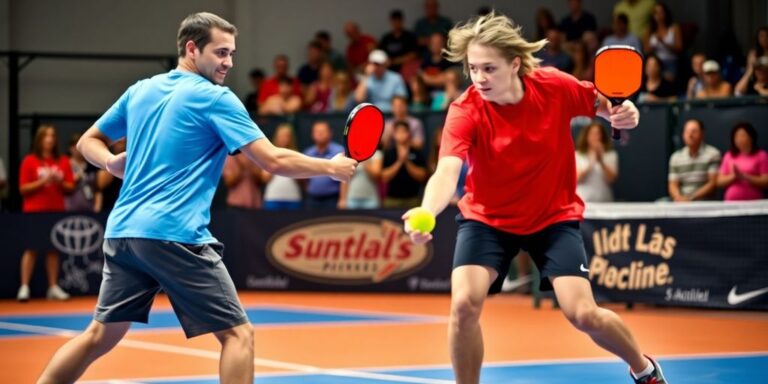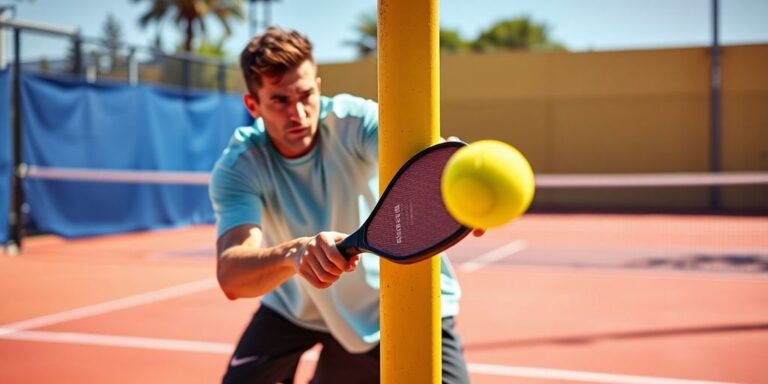An unreturned serve in pickleball, often referred to as an “ace,” can be a game-changer. Whether you’re just starting out or have played for a while, knowing how to serve effectively can ramp up your chances of scoring. In this article, we’ll cover the ins and outs of what makes a serve unreturned, the strategies to improve your serving game, and how to navigate the rules surrounding it. Let’s dive in and see how you can turn your serve into a weapon on the court!
Key Takeaways
- An unreturned serve, or ace, occurs when the opponent fails to return the ball, scoring a point for the server.
- Placement and spin on your serve can greatly increase your chances of scoring an ace.
- Understanding the rules of serving is crucial for executing a legal and effective serve.
- Varying serve speed and direction keeps your opponents guessing and can lead to more unreturned serves.
- Practicing your serve regularly helps build muscle memory and confidence, making your serves more effective.
Understanding the Mechanics of an Unreturned Serve in Pickleball

Definition of an Unreturned Serve
So, what exactly is an unreturned serve in pickleball? Simply put, it’s when you serve the ball, legally of course, and your opponent fails to return it. Boom! Point for you. It’s also often called an "ace," which sounds pretty cool, right? An unreturned serve is a game changer because it immediately puts pressure on the receiving team. It’s not just about power; it’s about placement and strategy, too. Think of it as the opening move in a chess game – a good one can set you up for success.
Key Characteristics of an Ace
An ace isn’t just any serve; it has specific characteristics. It needs to land within the boundaries of the correct service box, untouched by the receiving player. It has to follow all the serving rules, like the underhand motion and hitting it below the waist. If the ball nicks the receiver’s paddle but isn’t returned, it still counts! Here’s a quick rundown:
- Lands in the correct service box.
- Isn’t touched by the receiver (or is touched but not returned).
- Follows all serving rules.
- Results in an immediate point for the server.
Importance of Serve Placement
Okay, so you know what an unreturned serve is, but why is serve placement so important? Well, it’s not always about blasting the ball as hard as you can. Sometimes, a well-placed serve is way more effective. Think about it: if you can target your opponent’s weak side or make them move awkwardly, they’re less likely to return the ball successfully. It’s about making them uncomfortable. Consider these points:
- Target your opponent’s backhand: Many players have a weaker backhand, making it harder for them to return the serve effectively. Mastering pickleball involves exploiting these weaknesses.
- Aim for the deep corners: This forces your opponent to move further back, giving you more time to prepare for the next shot.
- Mix up your serve placement: Don’t be predictable! Varying your serve placement keeps your opponent guessing and makes it harder for them to anticipate your serve.
Serve placement is key. It’s not just about power; it’s about making your opponent move and react in a way that makes it difficult for them to return the ball. Think strategy, not just strength.
Techniques for Executing an Effective Serve
Mastering the Basics of a Powerful Serve
Okay, so you want to up your serve game? It all starts with the basics. A solid foundation is key to a serve that’s both powerful and accurate. Think of it like building a house – you can’t have a fancy roof without a strong base, right?
First, your grip matters. You want it firm, but not so tight that you’re squeezing the life out of your paddle. A relaxed grip lets you transfer power more smoothly. Next, think about your stance. Feet shoulder-width apart, weight balanced, ready to move. And don’t forget the underhand serve – that’s pickleball law! Make sure you’re contacting the ball below your wrist. It might feel weird at first, but you’ll get used to it. Practice your pickleball serve often.
- Grip: Firm but relaxed.
- Stance: Balanced and ready.
- Contact Point: Below the wrist.
A lot of people think power is all you need, but control is just as important. You could have the hardest serve in the world, but if it’s landing out, what’s the point? Focus on hitting your target consistently.
Advanced Serving Strategies
Alright, you’ve got the basics down. Now it’s time to get fancy. Advanced serving is all about mixing things up and keeping your opponent guessing. We’re talking spin, placement, and timing. It’s like being a magician – you want to create illusions and make the ball do things they don’t expect.
Mastering spin can really transform your serve. Topspin makes the ball dip sharply, while backspin makes it float. Experiment and see what works for you. Placement is also key. Don’t just aim for the middle every time. Try the corners, or right down the center line. These spots are tough to return. And pay attention to your opponent’s position. Are they leaning one way? Serve to the other! Are they close to the kitchen? A high, soft serve might catch them off guard. You can find a pickleball partner to practice with.
- Topspin: Ball dips sharply.
- Backspin: Ball floats.
- Placement: Vary your targets.
Incorporating Spin and Speed Variations
Spin and speed variations are your secret weapons. They add another layer of complexity to your serve and make it much harder for your opponent to predict. Think of it like this: if you only throw fastballs, eventually they’re going to figure it out. You need to mix in some curveballs and changeups.
Try adding topspin for a serve that dives at their feet, or backspin for a floater that messes with their timing. And don’t be afraid to change your speed. A slow, high serve can be just as effective as a hard, flat one. The key is to keep them guessing. Also, remember that the bounce serve is a legal serve.
- Topspin for a diving serve.
- Backspin for a floating serve.
- Vary your serve speed.
Rules Governing Unreturned Serves
Official Serving Regulations
Okay, so when it comes to serving in pickleball, there are some things you just have to get right. The serve must be underhand, and contact with the ball has to be below your wrist. It’s not tennis, folks! You also need to serve diagonally across the court, and the ball needs to clear the non-volley zone (aka the kitchen). If you mess any of that up, it’s a fault.
Criteria for a Legal Serve
What makes a serve "legal" anyway? Well, a few things. First, it’s gotta start with both feet behind the baseline – no jumping forward to get an advantage. Second, you can’t bounce the ball and then serve it; it’s gotta be a continuous motion. And third, the ball has to land within the correct service court. If it lands out, hits the net and doesn’t make it over, or doesn’t go diagonally, it’s a fault. Understanding pickleball rules is key to avoiding these mistakes.
Here’s a quick rundown:
- Feet behind the baseline
- Underhand serve
- Contact below the wrist
- Diagonal serve
- Clear the kitchen
Consequences of Faulty Serves
So, you messed up your serve. What happens now? Well, if it’s your first serve, you get a second chance. But if you fault on your second serve, it’s a side out, and the other team gets to serve. And remember, only the serving team can score points, so you’re giving up a scoring opportunity. Also, if you’re playing doubles, your partner doesn’t get to serve if you fault on your second serve; it’s straight to the other team. It’s important to practice two-player format to minimize these errors.
Faulty serves can really kill your momentum. It’s not just about losing the point; it’s about giving the other team an advantage and letting them control the game. Focus on consistency and accuracy, and you’ll avoid those costly mistakes.
Strategies for Achieving an Unreturned Serve
Varying Serve Placement
Placement is key. Don’t just aim for the middle every time. Mix it up! Try aiming for the deep corners of the service court, or even right down the center line. These spots can be tough for your opponents to reach and return effectively. Think about where your opponent isn’t, and put the ball there.
Mixing Up Serve Speeds
Don’t be predictable. If you always serve with the same speed, your opponent will adjust. Throw in some slow serves, some fast serves, and see how they react. A change of pace can really throw them off balance. It’s like a pitcher in baseball changing speeds on their fastball.
Targeting Opponent Weaknesses
Pay attention to your opponent. Do they struggle with backhands? Are they slow to move to their left? Exploit those weaknesses! Serve the ball where they’re least comfortable. It’s all about observation and adaptation. If they have trouble with field sports equipment, they might not be as agile on the court.
Think of your serve as a chess move. You’re not just hitting the ball; you’re setting up the next shot. By targeting weaknesses and varying your placement and speed, you can force errors and gain an advantage.
Impact of an Unreturned Serve on Game Dynamics

Building Confidence for the Serving Team
An unreturned serve, or ace, can really boost the serving team’s morale. It’s like a quick win that says, "We’re here to play!" That immediate point can shift the energy and make the serving team feel more in control.
Creating Pressure on Opponents
Think about it: when you can’t even return the serve, it puts a lot of pressure on you. It makes you second-guess your positioning, your reaction time, and your overall game plan. It can lead to mistakes and a feeling of being constantly on the defensive. Here’s how it breaks down:
- Increased anxiety about the serve.
- Forced adjustments to receiving strategy.
- Potential for unforced errors.
Establishing Early Game Dominance
Getting those early aces can set the tone for the whole match. It shows the other team that you’re not messing around and that they’re going to have to work hard for every point. It’s a psychological advantage that can be tough to overcome. It’s like saying, "This is our court!" and backing it up with action. Mastering unreturned serves is a great way to achieve this.
An early lead, thanks to a few well-placed serves, can force the opposing team to play catch-up. This often leads to them taking more risks, which can result in further errors and solidify the serving team’s advantage. It’s all about controlling the pace and dictating the flow of the game right from the start. This is especially true in a tight match where every point counts.
Common Misconceptions About Unreturned Serves
Aces vs. Regular Points
It’s easy to get confused about what exactly constitutes an ace in pickleball. An ace is specifically a serve that lands in the correct service box and isn’t touched by the receiving team. A common mistake is thinking any unreturned serve is an ace. If the receiving team touches the ball, but fails to return it legally, it’s not an ace, but still a point for the serving team. It’s a service winner, but not an ace. Understanding this difference is key to accurately tracking your performance and strategizing. You can test your knowledge with a pickleball quiz.
Legal Serve Requirements
One big misconception is that you can just whack the ball as hard as you can and hope it goes in. There are very specific rules about how you have to serve. For example, the serve must be underhand, and you have to hit the ball below your waist. Also, you can’t bounce the ball and then hit it. It’s got to be a continuous motion. If you don’t follow these rules, it’s a fault, no matter how amazing the serve looks. It’s important to understand the official serving regulations.
Understanding the Let Rule
Another area of confusion is the "let" rule. A lot of people think that if a serve hits the net, it’s automatically a fault. That’s not true! If the serve hits the net but still lands in the correct service box, it’s a let. You get to serve again, no penalty. However, if it hits the net and lands out, then it’s a fault. It’s all about where the ball ends up. Remember to maintain your pickleball gear to avoid unnecessary faults.
It’s easy to think that power is everything when it comes to serves, but placement and spin are just as important. A well-placed serve with some spin can be much more effective than a hard serve that goes straight to your opponent’s paddle. Varying your serves keeps your opponent guessing and makes it harder for them to anticipate your next move. Coastal Waste’s new waste management arrangement is a good example of how a change can be beneficial.
Practicing for Success with Unreturned Serves
Okay, so you want to serve some aces, huh? It’s not just about raw power; it’s about smart practice. Let’s break down how to get those unreturned serves happening more often.
Drills for Improving Serve Accuracy
Accuracy is king (or queen!) when it comes to serving. You can have the most powerful serve in the world, but if it’s landing out, it’s useless. Here’s how to dial it in:
- Target Practice: Set up targets in the service box. Start with large targets and gradually make them smaller as you improve. This helps you focus on specific spots. Aim for the deep corners to make it harder for your opponent to return.
- Consistency Drills: Forget power for now. Focus on hitting the same spot repeatedly. This builds muscle memory and helps you develop a consistent serving motion. Try to hit ten serves in a row into the same area.
- Varying Serve Height: Practice serving with different ball toss heights. Some players find they are more accurate with a higher toss, while others prefer a lower one. Find what works best for you. This can also help you master the lob shot and keep your opponent guessing.
Remember, it’s better to have a consistent, accurate serve than a powerful, erratic one. Focus on hitting your spots, and the aces will come.
Building Muscle Memory
Muscle memory is what allows you to serve consistently without thinking too much about it. Here’s how to build it:
- Repetition, Repetition, Repetition: The more you practice, the more ingrained the serving motion becomes. Aim for at least 30 minutes of serving practice per session.
- Slow and Steady: Start by serving slowly and deliberately, focusing on proper form. As you become more comfortable, gradually increase your speed.
- Visualize Success: Before each serve, visualize the ball landing exactly where you want it to. This mental rehearsal can help improve your accuracy.
Setting Goals for Serve Improvement
Having clear goals can help you stay motivated and track your progress. Here are some examples:
- Accuracy Goal: "I will hit 7 out of 10 serves into the service box."
- Consistency Goal: "I will serve 5 serves in a row into the same target area."
- Ace Goal: "I will serve at least one ace per game."
Don’t be afraid to adjust your goals as you improve. The key is to keep challenging yourself and striving for continuous improvement. Keep track of your progress to see how far you’ve come!
When you practice returning serves that your opponent doesn’t hit back, you’re setting yourself up for success. This kind of training helps you get better at reading the game and reacting quickly. Want to learn more tips and tricks to improve your game? Visit our website for helpful resources and guides!
Wrapping It Up
In conclusion, grasping the concept of unreturned serves in pickleball can really change how you play. Whether you’re just starting out or have been playing for a while, a solid serve can make a big difference in your game. Remember, it’s not just about power; placement and spin are key too. Keep practicing those serves, mix things up, and don’t hesitate to try new techniques. With time and effort, you’ll find yourself scoring more aces and feeling more confident on the court. So, get out there, have fun, and let’s ace those serves!
Frequently Asked Questions
What is an unreturned serve in pickleball?
An unreturned serve happens when the player serving hits the ball, and the other team fails to return it. This scores an immediate point for the serving team.
How can I improve my serving technique?
To get better at serving, practice regularly. Focus on hitting the ball accurately first, then try adding power and different spins.
What are the rules for serving in pickleball?
You must serve from behind the baseline, hit the ball underhand, and aim diagonally to the opposite service box. The ball should also clear the non-volley zone.
Can I score points when I’m receiving?
No, in pickleball, only the serving team can score points.
What happens if my serve hits the net?
If your serve hits the net but still lands in the correct area, it’s called a ‘let,’ and you get to serve again.
What is the best strategy for serving?
To serve effectively, mix up your serve placements and speeds, and aim for your opponent’s weaknesses to make it harder for them to return the ball.




